#nyctanthes
Note
re: the writing ask, 7 and 14!
hi! thank you for the ask ❤️
7 - what character do you enjoy writing most and why?
already answered
14 - what is your favorite relationship featured in your fic aside from the main couple?
cant figure out how i should interpret this question lol. like my favorite couple or just any pair of characters?
if nonromantic st pair, i’ve enjoyed playing with nancy and mike a lot lately. though outside of my wips, i havent yet gone into depth with them the way that i want (its mostly just been like; little brother disgust; eldest daughter rage; lets mix these two ingredients; we get fun sibling rivalry) but yeah i think deep down there is this flicker of softness between the two of them, a weird sense of understanding. i dunno.
if romantic st pair…honestly joyce and lonnie? but again im not sure how to interpret the question, maybe im mistaken on what its asking. because yes i think they are my second favorite relationship to write but its certainly not my (or anyone’s) ship to ship. obviously. you know? i like to try and get into the joyce and lonnie stuff because i enjoy parsing out Past Joyce. not to say that that girl is gone completely but i dont know, i find it easy to write about her victimhood and the way she would have naturally been more susceptible when younger. more surprised. and powerless. she definitely fell on denial to cope with the abuse and thats sad but i guess i like writing about it anyways. however i can only think of a couple things i’ve published that really center on this (this flashback chapter of a fic i kinda quit and this oneshot with her feelings abt the pregnancy).
but yeah i might have not answered that quite right? to clarify my second favorite ship in the show in general is lucas and max but i’ve always ran into trouble trying to write about the kids or show their point of view. so when i say joyce and lonnie is my favorite, i mean out of what i have written, and i only mean that its interesting to explore joyce in that way. like to reiterate, i dont find their relationship’s toxicity “exciting” or anything. i will shut up now i think you know what i mean!
thanks so much again! so good to see you in my inbox :)
send me a fic ask
#stranger things#writing#*ask#nyctanthes-arbor-tristis#joyce byers#nancy wheeler#mike wheeler#lonnie byers
2 notes
·
View notes
Note
Maddie - Yay, great! 👏🏼
Here are the questions! Looking forward to reading your responses… 😊
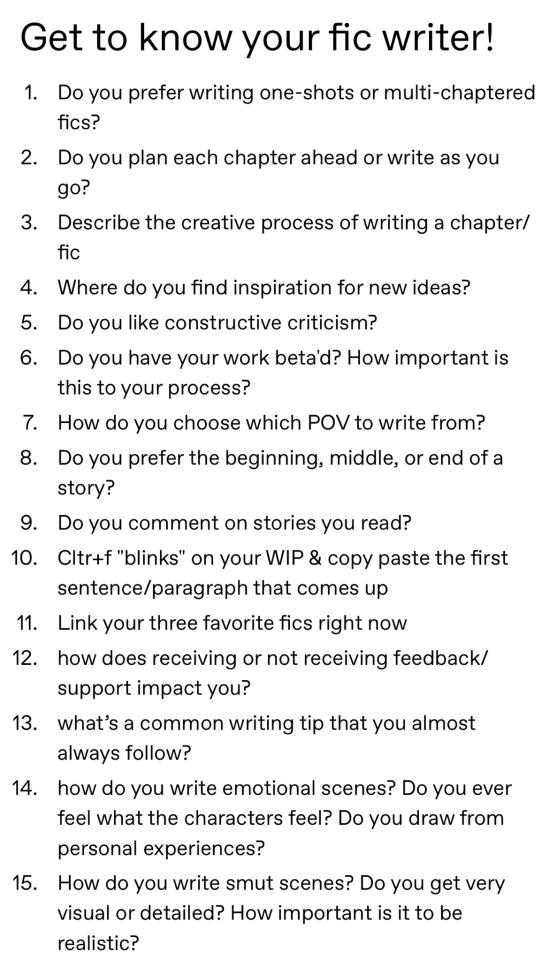
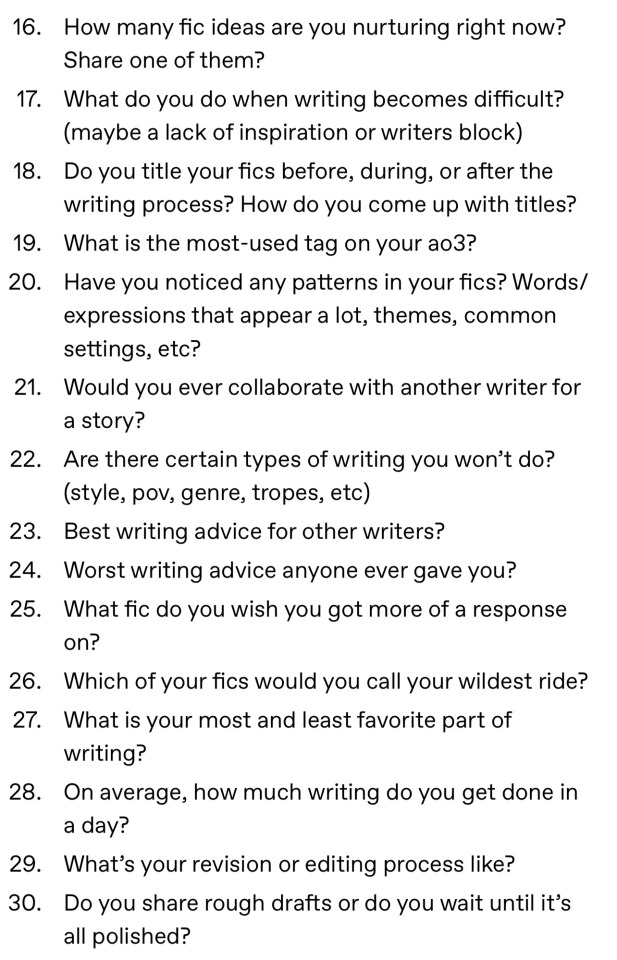
I mostly have ideas for multi-chapter fics, especially when it comes to Jancy, but I think I like writing one-shots more.
I usually do a very rough outline before starting a chapter (a list of scenes/plot points/goals) but revise it a lot as I go (like deciding to combine two scenes or insert a new one).
Usually I have a couple of vague ideas about plot points and vibes first. For example, with Drive All Night, it occured to me that the S1 Jancy scene where they practice shooting in the woods had Bonnie and Clyde vibes, and then I saw the 1932 movie Wild Boys of the Road and liked how it escalated from "teen comedy set during Depression" to "bleak chaotic Depression Era social drama with really satisfying violence." I let those ideas percolate a little and maybe ramble about them on Tumblr or to my IRL friend who's never watched Stranger Things. Then I write a first chapter to see if it has legs. If I'm having fun and feel intrigued about what's going to happen next, I continue. With one-shots, I usually have a specific idea I want to convey, so I think more about the overall arc I want and how each scene pushes towards that.
I get a lot of ideas from watching other media and deciding that I want to put characters in that kind of situation. I have a Jancy-Byler idea (pretty low on things that I'd actually write) where Jonathan, Will, and El are siblings who have powers (mind-reading, being a medium, and telekinesis, respectively) during the 1930s and work for carnivals before deciding to run a con on the town of Hawkins (particularly the Wheeler and Harrington families, about to unite through the marriage of Nancy and Steve). This came about because I love the movie The Brothers Bloom and had recently watched the remake of Nightmare Alley. Sometimes fandom discourse provides inspiration. For Tonight, Tonight, for example, I got annoyed with people not understanding why Jonathan initially thinks Joyce is losing her mind re: the lights and so decided to write an AU where his worst fears come to pass; exploring the consequences for Nancy kind of followed from that.
I've participated in a lot of writing workshops and really appreciate constructive criticism in the right context, but on a fanfic I've already posted, from someone whose tastes/goals may be very different from my own, is not that context. People are entitled to their opinions, but at that point I'm probably not going to change anything.
I don't have my work beta'd.
I have two dual POV WIPs going right now (Tonight, Tonight and my not-yet-posted Robin-and-Jonathan friendship fic) and two fics (Drive All Night and Ugly as Sin) with a single POV. It depends partly on who's the main character (Ugly as Sin is way more about Chrissy than Eddie or anyone else), who's going through the more dramatic changes (Nancy in Drive All Night), and how much information I want to convey.
I like the middle of a story, because that's when everything gets complicated. Endings are the hardest to write.
Yes, I comment, but not as much as I would like to!
“Look, I get it,” she said, blinking rapidly. “Robin’s the pretty one. But she’s also really immature and flaky, and she’s never going to go out with you.” [Spoken to Jonathan by one of Robin's friends; he knows she's a lesbian and does not in fact want to go out with her, but he's like "hey" on her behalf.]
Off the top of my head: already wise, already worn by throttlegainwell; How Do We Get to There from Here? by nyctanthes; and where the hours bend by fakelight.
I don't need a ton of feedback, but just one person saying that they like or want to see more of something makes all the difference.
Don't get too attached to your vision of how a scene/chapter should go if it's not working in the moment. Also, if I want to do something weird or risky or gross, it's probably actually a good idea.
Sometimes emotional scenes come really easy, but other times I have to sit down and outline everything the characters might be feeling so I can decide how much to reveal/describe. There's always a decision to be made how direct to be about a character's feelings; there's a time to convey it really subtly through how the character perceives their environment and their body language and all, but there's also a time to go "he felt like shit." And I do feel what the characters feel, quite often! I cried a lot writing Tonight, Tonight, let me tell you. I also draw from personal experience a lot, although it's not always super-direct.
There's so much pressure in writing smut scenes! I generally don't try to make them "sexy" so much as I try to convey what the characters are feeling (i.e., that they like looking at each other and enjoy what they're doing). How graphic I get usually depends on the character's attitude and the pacing of the story. I value sexual frankness in writing in general, though.
Three active WIPs (two posted) and twenty other ideas, roughly. My two big ideas are (a) a slice-of-life No Upside Down AU centered on Nancy, Jonathan, Mike, and Will and (b) a film noir homage with some Gone Girl stuff going on.
I leave it for a little while. Then I go back and try to figure out where I stopped getting interested, or I skip to the "good part."
I usually come up with a title towards the beginning of the writing process and then change it a million times. Mostly I get titles from song lyrics.
Looking at "additional tags" only, "Child Abuse" and "Minor Steve Harrington/Nancy Wheeler" are in the lead. Jonathan and Chrissy are both going through it usually, and I do like writing Steve and Nancy as a temporary romance.
For some reason, "Jonathan buys a used car from Lonnie" is a scenario that comes up a lot? I like writing about food, clothes, and money. I like putting in random stuff that isn't really part of the current pop culture vision of the 1980s, like holdovers from the 1970s or how much awful TV everyone was watching.
Probably! I used to write stories with my best friend when we were in middle school (mostly original stuff) and that was always really fun.
I probably wouldn’t write a crossover with a work that’s already shown up a lot in the fandom (like It, The Black Phone, or Scream).
If you cut a passage from a story, save it in a separate document because it could be useful later.
So many people insist that “cum,” not “come,” should be used as a verb for orgasming, but that’s not true unless you’re going for the sleaziest vibe possible (no judgment).
I've been happy with the response on all my fics, but Tonight, Tonight, the Highway's Bright has a special place in my heart because it's so weird and sad.
Drive All Night, due to all the murders and crimes.
My favorite part is when you get a really good but unexpected idea, either out of the blue or after mulling things over for a while. My least favorite part is getting stuck on a scene because you can't figure out how to say that a character got up from a chair or something really silly like that.
250-500 hundred words, probably.
I'm a slow writer but I edit pretty fast. I check for typos and I take out unnecessarily wordy bits.
I share bits of rough drafts but not the whole thing.
11 notes
·
View notes
Note
what are your favorite words or name ideas like “rosehaunt” looking for inspiration 💕
Well I like the names my sister and I came up with for some of our necklaces on our shop: bladenoir & veilamour.
other words I like: labyrinthine, alchemical, opia, circean, aureate, mellifluous, nyctanthous, lavalier, aubade, belamour, ardour, ambrosial, ameliorate, ambedo, pendeloque, libellule 🤍
9 notes
·
View notes
Text
stranger things fic rec friday, 12/9/22
featuring will pov one-shots across the years, focusing on his trauma from the upside down and relationships with other characters
So This Is The Aftermath - nyctanthes (G, 3.4K)
post-S2, will finding his place again following the trauma of the mind flayer - such a tender, realistic portrait of healing and family and friends
Little Pockets of Upturned Loneliness (G, 5K)
another glimpse of the aftermath of possession and letting others see you and be there for you - written in 2017 and still a favorite
i know, i know, i know - aude_sapere (T, 32.8K)
s4 v2 rewrite, focusing on will’s connection with vecna and all the nightmares, semi-hallucinations, and byler get-together galore. SO well done
Press Me Between Your Pages (Preserve Me Like a Memory) - elsie (M, 11K)
post S4, will staying at the wheeler’s and there’s only one bed! with a incredibly well-done dose of inner turmoil and yearning
#pls pretend its still friday#fic rec friday#firefly's fic recs#byler fic#i promise next week i'll branch out a little akejdsfskx
22 notes
·
View notes
Text
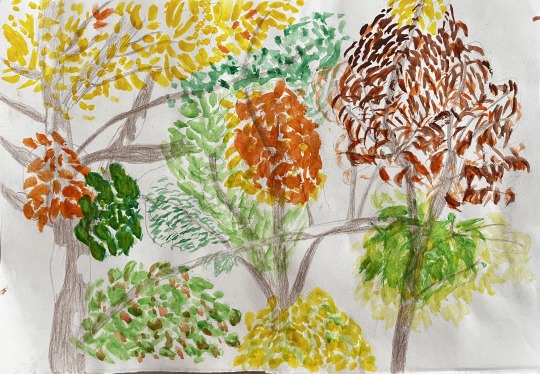
Claude Monet’s works were painfully criticized in the first impressionist exhibition as Tucker notes in his article The First Impressionist Exhibition and Monet’s Impression, Sunrise: a Tale of Timing, Commerce and Patriotism, but at least Monet challenged the academy and gave a piece of himself to the world with his works. Now his art is largely appreciated, there is even a museum in Paris dedicated entirely to his art – The Marmottan. His daring endeavors inspired me to create a painting. Even though it might seem unfinished or even childish, this is my most authentic try to capture nature as it is.
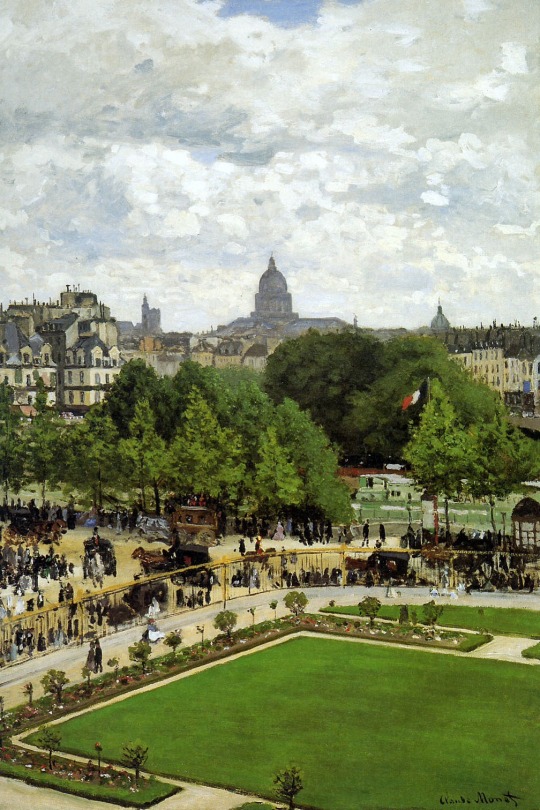
Claude Monet, The Garden of the Infante, 1867. Oil on canvas, 91,8 x
61,9 cm. Ohio, Oberlin College.
While I was drawing it, I was looking out of my window which is exactly what Monet did with his ‘Garden of the infante’ or ‘The Louvre Quay’. Even though his paintings are very detailed and almost look like a photograph, mine is rather, well, cannot even be compared to his!

Camille Pissarro, Apple Picking at Eragny-sur-Epte, 1888. Oil on canvas, 61 x 74 cm. Dallas, Museum of Art.
I would rather compare it to Pissarro’s ‘Apple picking at Eragny-sur-Epte’ because of the almost unreal looking tree. I notice that the people are drawn with a lot more attention to detail than the tree, which is a bit alien looking. Even though it looks like mine is lacking any detail, I tried to capture the character of almost every single leaf cluster, and even of the tree trunks and branches. I started with the trunks; they were the toughest to draw. A tree without leaves looks like a nervous system. There are countless divisions, I couldn’t draw all of them. Some tree trunks were darker than others, more narrow or wide, some had patches of lighter bark, some were bigger, some smaller, some closer, some farther away. Each of them was an individual. A live model. William Bartram writes in his excerpts about a hunting scene between a spider and a bumble bee. He describes in detail the appearance of the spider: ‘his body was about the size of a pigeon’s egg, of a buff color, which with his legs were covered with short silky hair, on the top of the abdomen was a round red spot or ocelle encircled with black’. Isn’t it peculiar how he pays such attention to such a small creature? And most importantly, why does he pay so much attention to observation? In the beginning of his excerpts he uses all sorts of scientific names for the most usual flowers and plants. ‘Cactus grandiflora, Gloriosa superba, Theobroma, Adansonia digitata, Nyctanthes’… Why? I think because they are special, although they might be the most usual. Detail makes everything special and unique. And while drawing I established a connection with the trees, I got to know them, I know their character. One is a bit pompous and proud (far right), one is wise and old (far left), one is rather young and careless (middle). Now, their leaves had character too. The far-left tree had to have more mellow-shaped leaves because it is wisest. Even its colors are softest. The far-right tree has its leaves like spikes like it is going to prick someone. The middle one has the most different shapes and colors of leaves – a sign of youth’s colorfulness. It certainly felt difficult to draw. I constantly asked myself questions, doubted myself and didn’t like my work throughout the process: ‘But how exactly do I draw this shape?’, ‘No, it shouldn’t look like that’, ‘I should use a bigger brush’. At a certain point I thought ‘There is no way I will be able to finish that’, because I had no idea what I was doing. But then I just let my hand paint. It felt like I had gone back to my children’s years, my hands, and clothes all dirty with paint, brushes were falling everywhere, a certain chaos had settled in. But I felt like a true artist, free and completely engulfed in my work. Isn’t that exactly what artistry is? Freedom and chaos? Well, if so, I know I did well.
-Neda
5 notes
·
View notes
Text
Parijat
The Parijat flower is often called Pavazhamalli. This Parjiat tree is said to the heavenly plant as this tree plant is believed to be bought by Lord Krishna to the earth. Majorly this flowering plant has much spiritual & medicinal importance.

Parijat tree
The Parijat tree is a small shrub, a perennial plant that grows up to the height of 3 to 4 feet tall tree.

Parijat flower
The flowers are very fragrant and look like coral (pavalam) with an attractive long orange stigma. Pinwheel flowers contain 5 to 8 petals together. Flower blooms in clusters. And this plant follows dusk & dawn timings.

Night jasmine
Parijat common name is Night flowering jasmine. The reason behind this night blooming is due to hormone called as florigen (flower-generating hormone) it gets migrated from leaves to flowering shoots during the day time & it collects in flowering shoots, induces flower during night time.

Nyctanthes arbor-tristis
This plant is scientific name called Nyctanthes arbor-tristis and belongs to the family Oleaceae ( jasmine family). This is not true jasmine but it is placed under the jasmine family for the fragrance.

Leaves
Night-blooming jasmine tree leaves are rough & contain D-mannitol, flavanol glycosides & others.

Soil
Well-drained sandy loamy soil with a good compost mixture such as cow manure or vermicompost.
And also grows well in a good organic coco peat potting mix.

SunlightNight-blooming jasmine plant is sun lovers and requires direct sun light for about 6 hours.

Water
Regular watering to plant is necessary as these plants are thirsty. Make the soil constantly moist by saturating it with water.

Fertilizer Application
Organic fertilizer application is a must during flower blooming seasons such as August- January.
Water the plants after fertilizer application.

Transplanting or Repotting
Transfer the plants to a good soil surface 5-6 months after planting. Repot the plants when the root ball grows through the drainage holes.
Pruning
Trim the old & dried plant parts.
Pest & Disease
In the Winter season, a woody caterpillar, mealy bugs & aphids may be found.


Control
The Neem oil or citrus oil is sprayed to the plants in diluted form only at the required. Avoid fertilizer application in direct sun light.

Benefit
The Parijat flower has mythological & spiritual importance.
In Ayurveda leaves & stem has the most importance. Cures joint pain, malaria, intermittent fever, coughs & cold.
These green leaves have anti-bacterial & anti-inflammatory properties.

Don’ts
The biggest enemy of this plant is over-watering & avoiding water spillage over the flowers which may lead to fungal attacks.
Timely pruning of the plants to avoid pest & disease.
Growing plants by organic & natural methods is an excellent practice. Promotes healthy food, and a more oxygenated environment improves soil health & makes your environment green, fresh & makes you stress-free.

Green Earth makes Happy Earth!!
Parijat flower plant- Eco-friendly plants.
Blog created by : Santhionlineplants
2 notes
·
View notes
Text
If anyone wants a good will centric post s2 fic about his emotional state and coping and whatnot thats kind of whimsical and a little sad then i highly suggest ‘so this is the aftermath’ by nyctanthes
#my post#stranger things#will byers#its really good#they have other fics that feature will but i havent read them#started one but didnt finish#if this ones good though then im assuming they are as well
5 notes
·
View notes
Text
Nyctanthes arbor-tristis, or Parijat. Wikipedia calls it night flowering jasmine, but that's a title bestowed upon Raat Rani, not Parijat. It is a small white flower with a gorgeous saffron center and stem, used in dyes.

This was suppised to look delicate but it's really got an eldritch feel. I think I need to sharpen my pencil.
3 notes
·
View notes
Text
Unlock the Mysteries of Harshringar: A Herbal Treasure for Holistic Health

Harshringar, also known as Parijat or Night-flowering Jasmine, is a sacred and ancient herb that has been revered for its therapeutic properties in Ayurveda for centuries. Its scientific name is Nyctanthes arbor-tristis, and it is native to South Asia and Southeast Asia. This plant is not only known for its stunning beauty, with fragrant white flowers and vibrant green leaves, but also for its remarkable health benefits. In this blog, we delve deep into the wonders of Harshringar and how it can enhance your well-being.
The Botanical Marvel of Harshringar
Harshringar is a small tree or shrub that can grow up to 10 meters tall. Its flowers bloom at night, emitting a sweet and intoxicating fragrance that has captivated people for generations. The plant's therapeutic uses are mainly attributed to its leaves, flowers, and seeds, which contain potent compounds like alkaloids, glycosides, and flavonoids.
Ayurvedic Benefits of Harshringar
Pain Relief and Inflammation Reduction
Harshringar is renowned for its analgesic and anti-inflammatory properties. Its leaves are often used to alleviate joint pain, arthritis, and muscular discomfort. By reducing inflammation, Harshringar helps improve mobility and enhances the quality of life for those suffering from chronic pain conditions.
Boosting Immunity
The leaves of Harshringar are rich in antioxidants, which help strengthen the immune system. Regular consumption of Harshringar leaf extract can help the body fight off infections and maintain overall health.
Respiratory Health
In Ayurveda, Harshringar is used to treat respiratory ailments such as cough, cold, and asthma. The leaves and flowers have expectorant properties that help clear the respiratory tract, making breathing easier and reducing symptoms of congestion.
Fever Reduction
Harshringar has antipyretic properties, making it effective in reducing fever. It is often used in traditional medicine to manage fever and related symptoms, helping patients recover faster.
Digestive Health
The leaves of Harshringar are known to improve digestion and relieve gastrointestinal issues. They help in detoxifying the liver, regulating bowel movements, and alleviating symptoms of indigestion.
Scientific Studies on Harshringar
Research on Harshringar has confirmed its traditional uses and highlighted its potential as a natural remedy. Studies have shown that Harshringar extracts possess significant anti-inflammatory, analgesic, and antioxidant properties. Researchers continue to explore its potential applications in modern medicine, particularly in treating chronic diseases and enhancing immune function.
Growing Harshringar at Home
For those interested in harnessing the benefits of Harshringar, cultivating the plant at home is a rewarding endeavor. Harshringar thrives in well-drained soil and requires moderate watering. It prefers a sunny location and can be grown from seeds or cuttings. With proper care, you can enjoy the beauty and health benefits of this remarkable plant right in your garden.
The Cultural and Spiritual Significance of Harshringar
Harshringar holds a special place in Indian culture and spirituality. It is often associated with various Hindu myths and is considered sacred in many traditions. The plant's fragrant flowers are used in religious ceremonies, and its spiritual significance adds another dimension to its holistic benefits.
SarabHerbs: Embracing the Power of Harshringar
At SarabHerbs®, we are dedicated to bringing you the finest natural products that harness the power of traditional herbs like Harshringar. Our range of herbal supplements, teas, and skincare products are crafted with care, ensuring that you receive the highest quality and efficacy. Whether you are looking to boost your immunity, relieve pain, or enhance your skincare routine, SarabHerbs has a product for you.
By choosing SarabHerbs®, you are not only investing in your health but also supporting sustainable and ethical practices. We are committed to preserving the rich heritage of herbal medicine and ensuring that these natural treasures are available for generations to come.
Incorporate Harshringar into your wellness journey with SarabHerbs® and experience the healing power of nature. Explore our products today and discover the benefits of this ancient remedy for yourself.
#plants#forest#nature#ayurvedic#stayinbed#wakeupfresh#vaculung#urjashakti#vaculiv#nirvapain#vackoff#uteroelight#papgoat#BOSWELLIA#NatureLovers#6d
0 notes
Text
Unveiling the Beauty and Benefits of the Harshingar Plant

In the world of botanical marvels, few plants capture the imagination quite like the Harshingar, also known as the Night Jasmine or Parijat. With its delicate flowers and rich cultural significance, the Harshingar plant holds a special place in gardens, folklore, and traditional medicine. Let's embark on a journey to explore the allure, uses, and fascinating facts surrounding this enchanting botanical wonder.
Introducing the Harshingar Plant:
Scientifically known as Nyctanthes arbor-tristis, the Harshingar is a small tree or shrub native to the Indian subcontinent and Southeast Asia. Its name, "Nyctanthes," is derived from Greek words meaning "night-blooming," a nod to the plant's distinctive feature of blooming at night. The term "arbor-tristis" translates to "sad tree," attributed to the melancholic fragrance of its flowers.
Blooms of Beauty:
The Harshingar plant is renowned for its exquisite flowers, which showcase a unique blend of beauty and mystique. These fragrant blossoms typically appear in clusters and consist of delicate white petals with vibrant orange centres. What sets them apart is their nocturnal blooming habit, with flowers opening at dusk and releasing a captivating aroma that permeates the surrounding air.
Cultural Significance:
Embedded in the cultural tapestry of regions where it grows, the Harshingar plant holds symbolic significance in various traditions and beliefs. In Hindu mythology, it is revered as the mythical Parijat tree, which is said to have originated from the churning of the ocean by gods and demons. Legend has it that the tree was brought to earth by Lord Krishna and planted in the garden of his beloved, Radha. Thus, the Harshingar is often associated with love, devotion, and divine blessings.
Medicinal Marvels:
Beyond its ornamental value and cultural symbolism, the Harshingar plant boasts a treasure trove of medicinal properties. In traditional Ayurvedic and folk medicine systems, various parts of the plant, including leaves, flowers, and bark, are utilized to treat a myriad of ailments. These include:
Anti-inflammatory properties: The leaves of the Harshingar plant are valued for their anti-inflammatory and analgesic properties, making them useful in alleviating conditions such as arthritis and joint pain.
Antipyretic effects: Decoctions made from the leaves are believed to have antipyretic properties, aiding in reducing fever.
Digestive aid: The Harshingar plant is also utilized as a digestive aid, with preparations made from its leaves used to treat digestive disorders like constipation and indigestion.
Respiratory health: Inhalation of the plant's vapours is thought to provide relief from respiratory ailments such as coughs, colds, and asthma.
Cultivation and Care:
For those keen on cultivating the Harshingar plant, it thrives in subtropical and tropical climates, requiring well-drained soil and ample sunlight. It is relatively low-maintenance, making it suitable for both gardens and containers. Regular pruning helps maintain its shape and encourages prolific flowering. While the plant is resilient, it may be susceptible to pests such as aphids and whiteflies, which can be addressed through natural or chemical means.
Conclusion:
In the realm of botanical wonders, the Harshingar plant stands out as a captivating blend of beauty, cultural significance, and medicinal utility. From its nocturnal blooms steeped in mythology to its therapeutic properties utilized for centuries, this remarkable plant continues to enchant and inspire. Whether adorning gardens, adulating altars, or adorning homes, the Harshingar plant is a testament to nature's boundless splendour and the enduring connections between plants and people.
1 note
·
View note
Text
NIGHT BLOOMING JASMINE PLANT
Pavala Malli or Parijat is a small shrub or tree originally from South Asia. Their flowers are worshipped as the flowers fit for the Gods. The word ‘parijat’ literally means descended from or celestial. The flower has a divine fragrance and in addition to medicinal values.
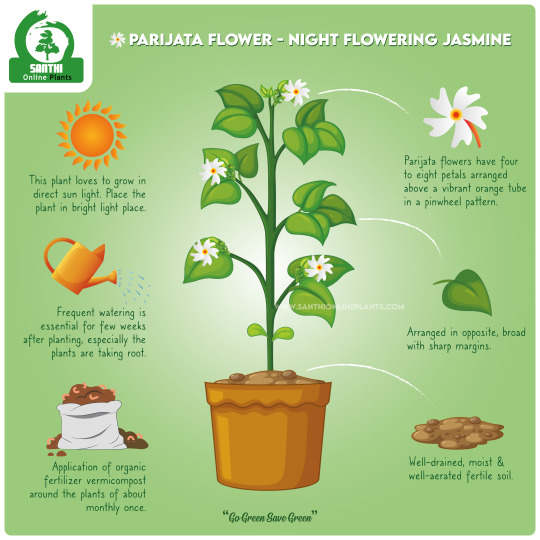
Name: Pavala Malli
Scientific name: Nyctanthes arbor-tristis
Origin: Originated from South Asia
Height: Plants can grow up to 10 meters or up to 33 feet
Family: Oleaceae (Olive family)
0 notes
Text
DGGI New Delhi Collaborate for Aravalli Ecosystem Conservation
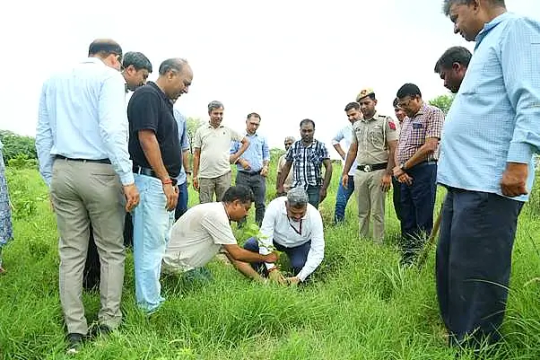
In the lead-up to Harit Mahotsav, officers and staff from the Directorate General of Goods and Services Tax Intelligence (DGGI) New Delhi came together for a meaningful cause.
In collaboration with the Department of Environment Studies, Delhi University, and Delhi Development Authority, they conducted a plantation drive at Aravalli Biodiversity Park in Vasant Kunj, New Delhi.
The objective was to supplement the conservation efforts of the Aravalli ecosystem.
Esteemed Participants and Expert Guidance
Name
Designation
Shri Surjit Bhujabal
Pr.DG, GSTI
Shri Samanjas Das
DG
Shri Rajesh Jindal
Pr. ADG
Shri B.B Gupta
Pr. ADG
Dr. M. Shah Hussain
Ecologist and Scientist in charge
Dr. Aisha Sultana
Ecologist
Dr. Dinesh Albertson W
Field Biologist
Dr. Rizwan Khan
Field Biologist
Dr. Dushyant Rathore
Field Biologist
Mr. Pradeep Pal Poonia
Supervisory Staff
Mr. Purushottam Pathak
Supervisory Staff
This table showcases the esteemed individuals and experts who actively participated in the plantation drive, along with their respective designations.
Enriching the Local Flora
Planting Native and Endemic Species
The plantation drive focused on the introduction of approximately 200 plants of local, endemic varieties and natural strains that are native to the Aravalli ecosystem.
By planting these species, the aim is to enrich the local flora and prevent the degradation of the ecosystem.
Furthermore, the initiative is expected to contribute to the conservation efforts of the Delhi Development Authority (DDA).
Endemic Local Species
Common Name
Albizia lebbeck
Siris
Bauhinia acuminata
Kachnar
Diospyros mlntana
Tendu
Kydia calycina
Bharanga
Murraya paniculata
Kadipatha
Nyctanthes arbor-tristis
Harsingar
Sapindus trifoliatus
Rita
Sapindus emarginata
Another type of rita
Senegalia modesta
Phulai
Senegalia catechu
Khayar
Senegalia senegal
Kumttha
Stereospermum chelonoides
Patlaa
Terminalia bellirica
Baheda
Terminalia elliptica
Aasan
Wrightia arborea
Duthi
Wrightia tinctorea
Another duthi
This table showcases the endemic local species planted during the drive, along with their corresponding common names.
Goals of the Plantation Drive
Promoting Biodiversity Conservation and Environmental Awareness
This significant Plantation Drive serves multiple purposes.
Firstly, it aims to create awareness about the preservation of biodiversity and habitat.
Secondly, it seeks to conserve keystone species and protect threatened plant and animal species.
Thirdly, the initiative aims to establish field gene banks for threatened landraces and wild genetic resources.
Additionally, the drive promotes education on environmental awareness and nature conservation. It also focuses on establishing native communities of the Aravalli hills and the River Yamuna basin, particularly in the Delhi region.
Moreover, the initiative seeks to develop a mosaic of treatment and catchment wetlands, which will not only improve the water quality of untreated sewage but also sustain the rich aquatic flora and fauna of the Yamuna.
Lastly, the project aims to monitor short-term and long-term changes in the ecology of the Delhi region.
Conclusion
The collaboration between the Directorate General of Goods and Services Tax Intelligence (DGGI) in New Delhi, the Department of Environment Studies at Delhi University, and the Delhi Development Authority for the plantation drive at Aravalli Biodiversity Park demonstrates a commitment to preserving the region's delicate ecosystem.
The initiative not only enriches the local flora but also promotes environmental awareness and conservation efforts.
By focusing on the conservation of keystone species, establishing gene banks, and enhancing water quality, this project contributes to the long-term sustainability of the Aravalli ecosystem and the Delhi region as a whole.
Sources: THX News & The Government of India.
Read the full article
#AravalliBiodiversityPark#Aravalliecosystemconservation#Conservationefforts#DelhiDevelopmentAuthority#Delhiregionecology#DepartmentofEnvironmentStudies#Environmentalawareness#HaritMahotsavplantationdrive#Keystonespeciespreservation#Nativeandendemicplants
0 notes
Text
Night Blooming jasmine
Pavala Malli or Parijat is a small shrub or tree originally from South Asia. Their flowers are worshipped as the flowers fit for the Gods. The word ‘parijat’ literally means descended from or celestial. The flower has a divine fragrance and in addition to medicinal values.
Name: Pavala Malli
Scientific name: Nyctanthes arbor-tristis
Origin: Originated from South Asia
Height: Plants can grow up to 10 meters or up to 33 feet
Family: Oleaceae (Olive family)

0 notes
Text
Coral Munga Gemstone
What is Coral Munga?
I'm not exactly sure who or what you mean by "Coral Munga." You might be referring to the "Munga Coral" or "Coral Jasmine" plant species (Latin name: Nyctanthes arbor-tristis). This shrub is indigenous to Southeast Asia, and it bears white or yellowish blooms with a powerful, sweet scent.
The Coral Jasmine's blossoms are used for religious or therapeutic purposes in some civilizations. For instance, the blossoms are occasionally utilised in Hindu religious events, and different sections of the plant are employed in Ayurvedic medicine to treat a wide range of illnesses.
But if you have more specific details or context, please let me know and I'll try to give you a more precise response.
What are the Benefits of Coral Munga?
As I have indicated, for millennia, numerous cultures have employed the herb Coral Munga, also known as Coral Jasmine, in traditional medicine. The following are a few possible advantages of Coral Munga:
Anti-inflammatory Compounds: Coral Munga's leaves and blooms contain substances that have anti-inflammatory qualities that may help lessen pain and inflammation.
Coral Munga has anti-oxidant characteristics that may help lower the risk of chronic diseases like cancer, heart disease, and Alzheimer's disease by assisting the body in neutralising damaging free radicals.
Compounds found in the plant may have antibacterial effects and may aid in the treatment of various bacterial and fungal illnesses.
Health of the respiratory system: Coral Munga has been used in traditional medicine to treat respiratory conditions like coughing,
What is the energy of Coral Munga?
Plants are frequently thought to have different energies that might influence a person's physical, emotional, and spiritual well-being in traditional medicine and holistic healing techniques. Coral Jasmine, also called as Coral Munga, is thought to contain a cooling energy that can assist to balance and calm the body and mind.
Coral Munga is characterised as having a "pitta-pacifying" energy in accordance with conventional Ayurvedic medicine, which implies it can assist the body balance the "pitta" dosha or energy type. Pitta dosha is linked to heat, intensity, and metabolism; when it is out of balance, it can cause problems such as inflammatory bowel disease, indigestion, and skin irritation. It is thought that the Coral Munga's cooling energy can balance pitta dosha and lessen these symptoms.
Coral provides cooling power in addition to
Does Coral Munga attract money?
Coral Munga, also known as Coral Jasmine, does not, according to any conventional wisdom or empirical data that I am aware of. Coral Munga is not known to be related with financial prosperity, despite the fact that plants and herbs are frequently linked to specific energies and qualities like healing, protection, or love.
Having said that, it's crucial to keep in mind that cultures and traditions can have very different beliefs and practises about plants and their energies. It may be unique to a certain culture or custom if you have heard of a specific idea that Coral Munga attracts money or fortune.
For More Information:- https://www.shraddhashreegems.com/loose-coral-stone-munga-stone/
0 notes
Text
Pavala Malli

Pavala Malli or Parijat is a small shrub or tree originally from South Asia. Their flowers are worshipped as the flowers fit for the Gods. The word ‘parijat’ literally means descended from or celestial. The flower has a divine fragrance and in addition to medicinal values.
Name: Pavala Malli
Scientific name: Nyctanthes arbor-tristis
Origin: Originated from South Asia
Height: Plants can grow up to 10 meters or up to 33 feet
Family: Oleaceae (Olive family)
https://www.santhionlineplants.com/
0 notes